Anti-Condensation Performance of a New Superhydrophobic Coating for Pavements
Abstract
:1. Introduction
2. Theoretical Analysis of Ice Suppression Performance of Superhydrophobic Surfaces due to Condensation
3. Experiment
3.1. Sample Preparation
3.1.1. Testing Raw Materials
3.1.2. Preparation Steps
3.2. Test Methods
3.2.1. Apparent Morphology
3.2.2. Water Contact Angle Test
3.2.3. Freezing Experiments
- Three specimens with identical dimensions were prepared for ordinary uncoated specimens, hydrophobic coated specimens, and superhydrophobic coated specimens 1 and 2, respectively.
- The sample was placed in a temperature control box, and 5 mL of water droplets were carefully deposited onto the surface of each specimen.
- The morphology of the frozen water droplets was observed. To minimize operational errors, five sets of experiments were conducted for each condition.
3.2.4. Ice Adhesion Strength Test
- Prepare concrete specimens measuring 100 mm × 100 mm × 100 mm in advance and place them into a mold measuring 400 mm × 100 mm × 100 mm. Separate the two specimens with a plastic film, leaving a 100 mm gap at each end.
- Fill the empty slots at both ends with water, ensuring that the water comes into contact with the side of the specimen that will be used for the test surface. Transfer the mold to a freezer set at a temperature of 10 °C. After 4 h, remove the mold from the freezer. At this point, the specimens and water will have frozen into two rectangular iced concrete specimens measuring 200 mm × 100 mm × 100 mm.
- Demold the frozen concrete specimens and place them onto a press. Position two arc-shaped pads at the interface between the specimens and the ice on both ends. Prior to use, ensure that the arc-shaped pads are subjected to the same freezing conditions as the specimens, ensuring that pads with different temperatures do not impact the bond between the ice and the concrete specimens. Apply pressure to the specimen using the HTC-1068 pressure tester (provided by Beijing Fuhaida Technology Co., Ltd., Beijing, China) until splitting occurs.
- Record the results and compile the data.
4. Results and Discussion
4.1. Microscopy of Superhydrophobic Materials
4.2. Effect of Condensation on the Water Contact Angle of Materials
4.3. Water Droplet Icing on Different Wettability Surfaces
4.4. The Law of Ice Adhesion Cover on Different Surfaces
5. Conclusions
- (1)
- Through theoretical discussions, we have uncovered the ice suppression capabilities of the superhydrophobic surface in relation to the condensate. It can be concluded that when the nano-gap of the superhydrophobic surface texture is lower than the critical nuclear radius of 145 nm under low humidity and high moisture environment, it prevents condensate droplets from entering the surface texture, allowing liquid water to remain in the Cassie state on the superhydrophobic surface. This inhibits the formation of mechanical interlocking effects, which can increase ice adhesion on the surface.
- (2)
- The surface of the superhydrophobic coating is composed of micro- and nano-papillae. Even in conditions of low temperatures and high humidity, condensation on the superhydrophobic surface does not affect its water contact angle, which is 151.9° with little change compared to the pre-condensation angle of 154.0°, ensuring continued strong superhydrophobicity. The large contact angle conceals the air in the gap of the coarse structure, which delays the icing time of the droplets and reduces the contact surface of the droplet with the superhydrophobic coating.
- (3)
- After investigating the adhesion of ice on a variety of wettability surfaces, our findings revealed that the adhesion force of hydrophilic surfaces with ice is the most robust, up to 947.75 N. In contrast, it can be observed that the presence of air within the microstructure of superhydrophobic surfaces significantly reduces the ice adhesion, with an adhesion of 214 N, without any observable mechanical interlocking effect.
Author Contributions
Funding
Institutional Review Board Statement
Informed Consent Statement
Data Availability Statement
Acknowledgments
Conflicts of Interest
References
- Wenqi, Z. Analysis of skid resistance of icy pavement and its impact on traffic safety. J. Wuhan Univ. Technol. 2014, 36, 58–62. [Google Scholar]
- Qiu, X.; Xu, J.-X.; Tao, J.-Q.; Yang, Q. Asphalt Pavement Icing Condition Criterion and SVM-Based Prediction Analysis. J. Highw. Transp. Res. Dev. 2018, 12, 1–9. [Google Scholar] [CrossRef]
- Lina, Z.; Qingyun, M.; Guiming, Y. Analysis of the impact of low temperature rain and snow freeze on key industries and the causes of disaster in China in early 2008. Clim. Environ. Res. 2008, 13, 11. [Google Scholar]
- Bingchen, Z.; Shumin, L. Exploration of snow removal on roads in winter. Shandong Traffic Sci. Technol. 2004, 2, 4. [Google Scholar]
- Yiqiu, T.; Huining, X.; Chi, Z. Old methods and new technologies of snow removal. China Highw. 2018, 511, 53–57. [Google Scholar]
- Fay, L.; Shi, X. Environmental Impacts of Chemicals for Snow and Ice Control: State of the Knowledge. Water Air Soil Pollut. 2012, 223, 2751–2770. [Google Scholar] [CrossRef]
- Xu, X.; Xiong, F.; Meng, J.; Wang, X.; Niu, C.; An, Q.; Mai, L. Vanadium-Based Nanomaterials: A Promising Family for Emerging Metal-Ion Batteries. Adv. Funct. Mater. 2020, 30, 1904398. [Google Scholar] [CrossRef]
- Liu, Z.; Sha, A.; Xing, M.; Li, Z. Low temperature property and salt releasing characteristics of antifreeze asphalt concrete under static and dynamic conditions. Cold Reg. Sci. Technol. 2015, 114, 9–14. [Google Scholar] [CrossRef]
- Datta, K.K.R. Exploring the Self-Cleaning Facets of Fluorinated Graphene Nanoarchitectonics: Progress and Perspectives. ChemNanoMat 2023, 9, e202300135. [Google Scholar] [CrossRef]
- Bhushan, B.; Multanen, V. Designing liquid repellent, icephobic and self-cleaning surfaces with high mechanical and chemical durability. Philos. Trans. R. Soc. A Math. Phys. Eng. Sci. 2019, 377, 20180270. [Google Scholar] [CrossRef]
- Archer, R.J.; Becher-Nienhaus, B.; Dunderdale, G.J.; Hozumi, A. Recent Progress and Future Directions of Multifunctional (Super)Wetting Smooth/Structured Surfaces and Coatings. Adv. Funct. Mater. 2020, 30, 1907772. [Google Scholar] [CrossRef]
- Arabzadeh, A.; Ceylan, H.; Kim, S.; Gopalakrishnan, K.; Sassani, A. Superhydrophobic Coatings on Asphalt Concrete Surfaces: Toward Smart Solutions for Winter Pavement Maintenance. Transp. Res. Board 2016, 2551, 10–17. [Google Scholar] [CrossRef]
- Antonini, C.; Innocenti, M.; Horn, T.; Marengo, M.; Amirfazli, A. Understanding the effect of superhydrophobic coatings on energy reduction in anti-icing systems. Cold Reg. Sci. Technol. 2011, 67, 58–67. [Google Scholar] [CrossRef]
- Jiajia, L.; Kaijian, H.; Jiaqing, W. Progress of ice suppression research on superhydrophobic materials for pavements. New Chem. Mater. 2023, 51, 223–228. [Google Scholar]
- Wang, J.; Dai, Q.; Si, R. Experimental and Numerical Investigation of Fracture Behaviors of Steel Fiber-Reinforced Rubber Self-Compacting Concrete. J. Mater. Civ. Eng. 2022, 34, 04021379. [Google Scholar] [CrossRef]
- Pilotek, S.; Schmidt, H.K. Wettability of Microstructured Hydrophobic Sol-Gel Coatings. J. Sol-Gel Sci. Technol. 2003, 26, 789–792. [Google Scholar] [CrossRef]
- Farhadi, S.; Farzaneh, M.; Kulinich, S.A. Anti-icing performance of superhydrophobic surfaces. Appl. Surf. Sci. 2011, 257, 6264–6269. [Google Scholar] [CrossRef]
- Chaudhuri, X.S. Design of anti-icing coatings using supercooled droplets as nano-to-microscale probes. Langmuir 2012, 28, 4434–4446. [Google Scholar]
- Subramanyam, S.B.; Kondrashov, V.; Rühe, J.; Varanasi, K.K. Low Ice Adhesion on Nano-Textured Superhydrophobic Surfaces under Supersaturated Conditions. ACS Appl. Mater. Interfaces 2016, 8, 12583–12587. [Google Scholar] [CrossRef]
- Shi, X. Characterization and Mechanism of a New Superhydrophobic Deicing Coating Used for Road Pavement. Crystals 2021, 11, 1304. [Google Scholar]
- Jisr, R.M.; HRmaile, H.; Schlenoff, J.B. Hydrophobic and Ultrahydrophobic Multilayer Thin Films from Perfluorinated Polyelectrolytes. Angew. Chem. Int. Ed. 2004, 44, 782–785. [Google Scholar] [CrossRef]
- Sarkar, D.K.; Farzaneh, M. Superhydrophobic Coatings with Reduced Ice Adhesion. J. Adhes. Sci. Technol. 2009, 23, 1215–1237. [Google Scholar] [CrossRef]
- Dotan, A.; Dodiuk, H.; Laforte, C.; Kenig, S. The Relationship between Water Wetting and Ice Adhesion. J. Adhes. Sci. Technol. 2009, 23, 1907–1915. [Google Scholar] [CrossRef]
- Petrenko, V.F.; Peng, S. Reduction of ice adhesion to metal by using self-assembling monolayers (SAMs). Can. J. Phys. 2003, 81, 387. [Google Scholar] [CrossRef]
- Petrenko, V.F.; Whitworth, R.W. Elastic, Thermal, and Lattice Dynamical Properties. In Physics of Ice; Oxford University Press: Oxford, UK, 2002. [Google Scholar]
- Bharathidasan, T.; Kumar, S.V.; Bobji, M.; Chakradhar, R.; Basu, B.J. Effect of wettability and surface roughness on ice-adhesion strength of hydrophilic, hydrophobic and superhydrophobic surfaces. Appl. Surf. Sci. 2014, 314, 241–250. [Google Scholar] [CrossRef]
- Kulinich, S.A.; Farzaneh, M. How wetting hysteresis influences ice adhesion strength on superhydrophobic surfaces. Langmuir ACS J. Surf. Colloids 2009, 25, 8854. [Google Scholar] [CrossRef]
- Murase, H.; Nanishi, K.; Kogure, H.; Fujibayashi, T.; Tamura, K.; Haruta, N. Interactions between heterogeneous surfaces of polymers and water. J. Appl. Polym. Sci. 1994, 54, 2051–2062. [Google Scholar] [CrossRef]
- Wang, J.; Luo, X.; Huang, X.; Ye, Y.; Ruan, S. Analysis on Effects of Joint Spacing on the Performance of Jointed Plain Concrete Pavements Based on Long-Term Pavement Performance Database. Materials 2022, 15, 8132. [Google Scholar] [CrossRef]
- Su, P.; Li, M.; Dai, Q.; Wang, J. Mechanical and durability performance of concrete with recycled tire steel fibers. Constr. Build. Mater. 2023, 394, 132287. [Google Scholar] [CrossRef]
- Chen, J.; Liu, J.; He, M.; Li, K.; Cui, D.; Zhang, Q.; Zeng, X.; Zhang, Y.; Wang, J.; Song, Y. Superhydrophobic surfaces cannot reduce ice adhesion. Appl. Phys. Lett. 2012, 101, 41–932. [Google Scholar] [CrossRef]
- Varanasi, K.K.; Deng, T.; Smith, J.D.; Hsu, M.; Bhate, N. Frost formation and ice adhesion on superhydrophobic surfaces. Appl. Phys. Lett. 2010, 97, 234102. [Google Scholar] [CrossRef]
- Liu, T.; Sun, W.; Li, X.; Sun, X.; Ai, H. Growth Modes of Condensates on Nanotextured Surfaces and Mechanism of Partially Wetted Droplet Formation. Acta Phys. Chim. Sin. 2013, 9, 9807–9815. [Google Scholar]
- Narhe, R.D.; Beysens, D.A. Growth Dynamics of Water Drops on a Square-Pattern Rough Hydrophobic Surface. Langmuir ACS J. Surf. Colloids 2007, 23, 6486. [Google Scholar] [CrossRef]
- Wilke, K.L.; Preston, D.J.; Lu, Z.; Wang, E.N. Toward Condensation-Resistant Omniphobic Surfaces. ACS Nano 2018, 12, 11013–11021. [Google Scholar] [CrossRef]
- Boreyko, J.B.; Chen, C.-H. Self-propelled dropwise condensate on superhydrophobic surfaces. Phys. Rev. Lett. 2009, 103, 184501. [Google Scholar] [CrossRef]
- Dorrer, C.; Rühe, J. Wetting of silicon nanograss: From superhydrophilic to superhydrophobic surfaces. Adv. Mater. 2008, 20, 159–163. [Google Scholar] [CrossRef]
- Chen, C.H.; Cai, Q.; Tsai, C.; Chen, C.L.; Xiong, G.; Yu, Y.; Ren, Z. Dropwise condensation on superhydrophobic surfaces with two-tier roughness. Appl. Phys. Lett. 2007, 90, 173108. [Google Scholar] [CrossRef]
- Feng, J.; Pang, Y.; Qin, Z.; Ma, R.; Yao, S. Why Condensate Drops Can Spontaneously Move Away on Some Superhydrophobic Surfaces but Not on Others. ACS Appl. Mater. Interfaces 2012, 4, 6618–6625. [Google Scholar] [CrossRef]
- Feng, J.; Qin, Z.; Yao, S. Factors Affecting the Spontaneous Motion of Condensate Drops on Superhydrophobic Copper Surfaces. Langmuir 2012, 28, 6067–6075. [Google Scholar] [CrossRef]
- Chen, X.; Wu, J.; Ma, R.; Hua, M.; Koratkar, N.; Yao, S.; Wang, Z. Nanograssed Micropyramidal Architectures for Continuous Dropwise Condensation. Adv. Funct. Mater. 2011, 21, 4617–4623. [Google Scholar] [CrossRef]
- Liu, X.Y. A new kinetic model for three-dimensional heterogeneous nucleation. J. Chem. Phys. 1999, 111, 1628–1635. [Google Scholar] [CrossRef]
- Cao, L.; Jones, A.K.; Sikka, V.K.; Wu, J.; Gao, D. Anti-Icing Superhydrophobic Coatings. Langmuir ACS J. Surf. Colloids 2009, 25, 12444–12448. [Google Scholar] [CrossRef] [PubMed]
- Ren, S.; Liu, X.; Li, M.; Fan, W.; Xu, J.; Erkens, S. Experimental characterization of viscoelastic behaviors, microstructure and thermal stability of CR/SBS modified asphalt with TOR. Constr. Build. Mater. 2020, 261, 120524. [Google Scholar] [CrossRef]
- Wang, Z.; Han, C.; Yu, Y.; Deng, H.; Li, C. Preparation and properties of superhydrophobic PVDF microporous composite membrane. Chem. Ind. Eng. Prog. 2018, 37, 673–680. [Google Scholar]

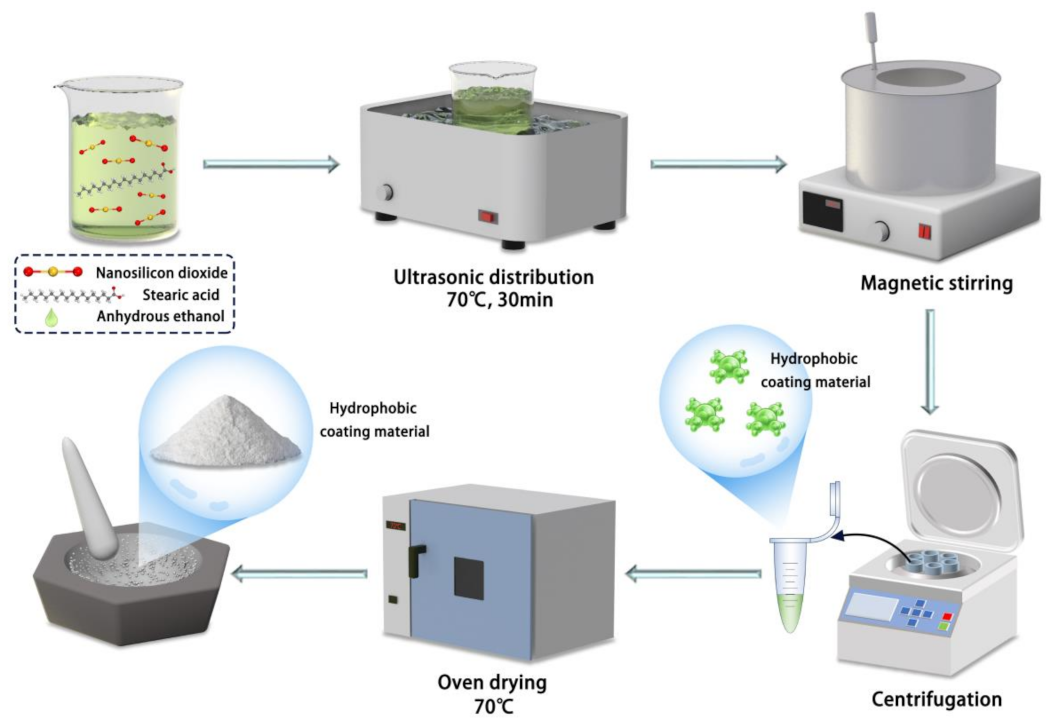
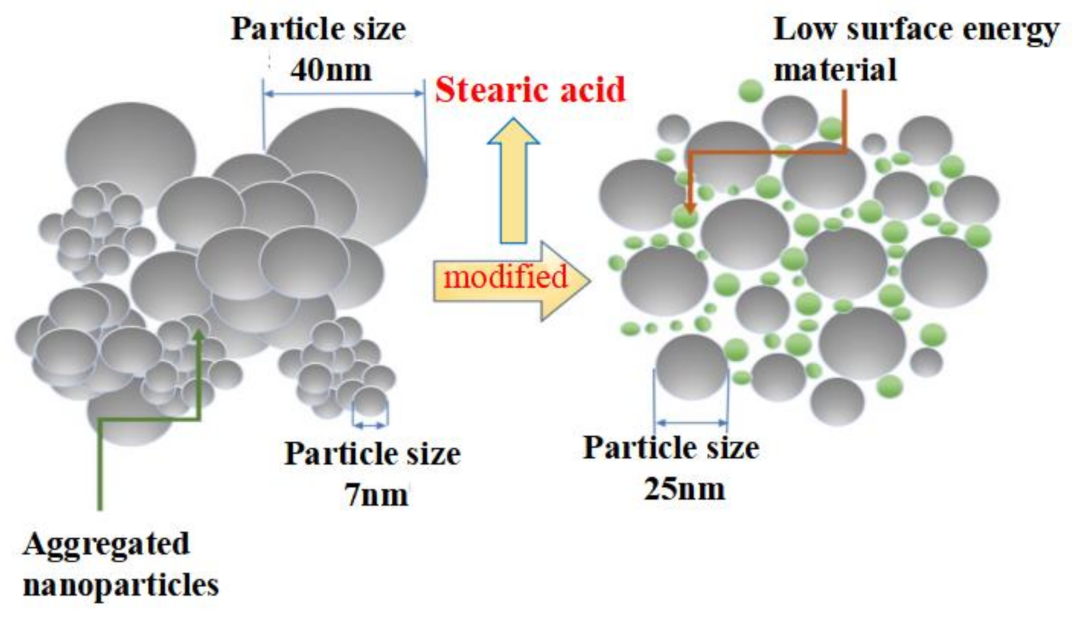


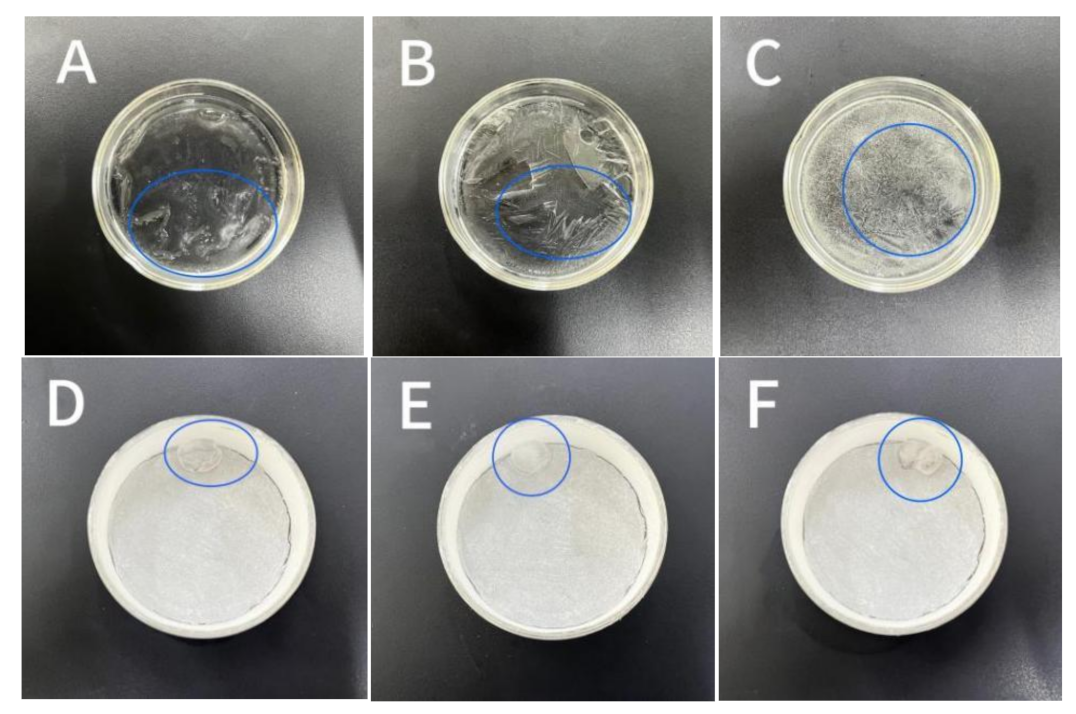
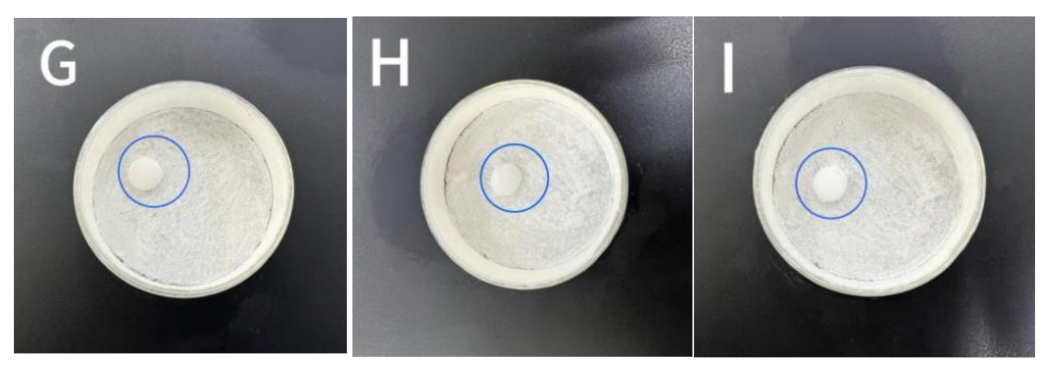
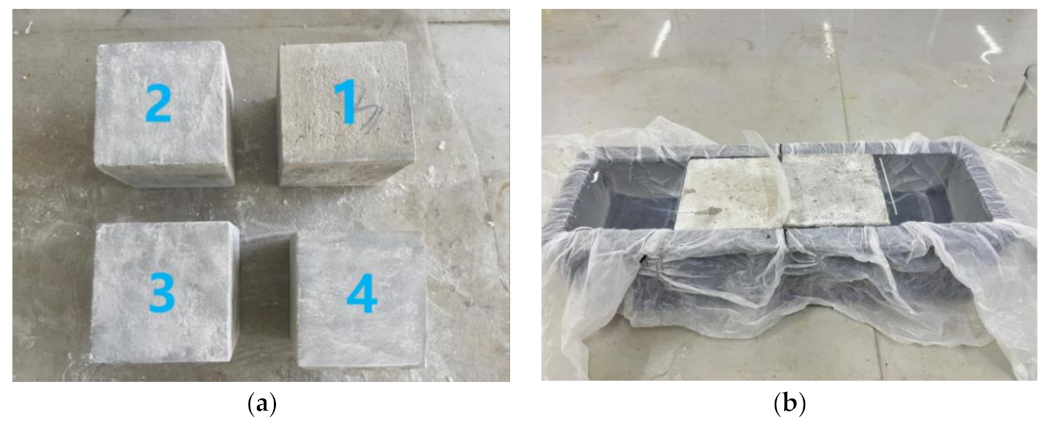


| Reagent Name | Specification | Manufacturers |
|---|---|---|
| tetraethyl orthosilicate | 98% | Sinopharm Chemical Reagent Co., Ltd. (Shanghai, China) |
| hydrochloric acid solution | 0.01 mol/L | Shanghai Da Biotechnology Co., Ltd. (Shanghai, China) |
| silicon dioxide | 7–40 nm | Sinopharm Chemical Reagent Co., Ltd. |
| stearic acid | AR | Sinopharm Chemical Reagent Co., Ltd. |
| anatase-structured titanium dioxide | 25 nm | Sinopharm Chemical Reagent Co., Ltd. |
| rutile-structured titanium dioxide | 60 nm | Sinopharm Chemical Reagent Co., Ltd. |
| anhydrous ethanol | AR | Sinopharm Chemical Reagent Co., Ltd. |
| deionized water | hyperpure | Laboratory homemade |
| Sample | Water Contact Angle (25 °C, RH = 30%) | Water Contact Angle (0 °C, RH = 70%) |
|---|---|---|
| Hydrophilic surface | 22.1° | 13.9° |
| Hydrophobic surface | 137.3° | 82.0° |
| Superhydrophobic surface 1 (Modified by anatase type nano titanium dioxide) | 151.9° | 147.8° |
| Superhydrophobic surface 2 (Modified by rutile type nano titanium dioxide) | 154.0° | 151.9° |
Disclaimer/Publisher’s Note: The statements, opinions and data contained in all publications are solely those of the individual author(s) and contributor(s) and not of MDPI and/or the editor(s). MDPI and/or the editor(s) disclaim responsibility for any injury to people or property resulting from any ideas, methods, instructions or products referred to in the content. |
© 2023 by the authors. Licensee MDPI, Basel, Switzerland. This article is an open access article distributed under the terms and conditions of the Creative Commons Attribution (CC BY) license (https://creativecommons.org/licenses/by/4.0/).
Share and Cite
Huang, K.; Sun, R.; Wang, J.; Shi, X.; Lei, H. Anti-Condensation Performance of a New Superhydrophobic Coating for Pavements. Materials 2023, 16, 5793. https://doi.org/10.3390/ma16175793
Huang K, Sun R, Wang J, Shi X, Lei H. Anti-Condensation Performance of a New Superhydrophobic Coating for Pavements. Materials. 2023; 16(17):5793. https://doi.org/10.3390/ma16175793
Chicago/Turabian StyleHuang, Kaijian, Ruiyu Sun, Jiaqing Wang, Xijun Shi, and Hechang Lei. 2023. "Anti-Condensation Performance of a New Superhydrophobic Coating for Pavements" Materials 16, no. 17: 5793. https://doi.org/10.3390/ma16175793
APA StyleHuang, K., Sun, R., Wang, J., Shi, X., & Lei, H. (2023). Anti-Condensation Performance of a New Superhydrophobic Coating for Pavements. Materials, 16(17), 5793. https://doi.org/10.3390/ma16175793





